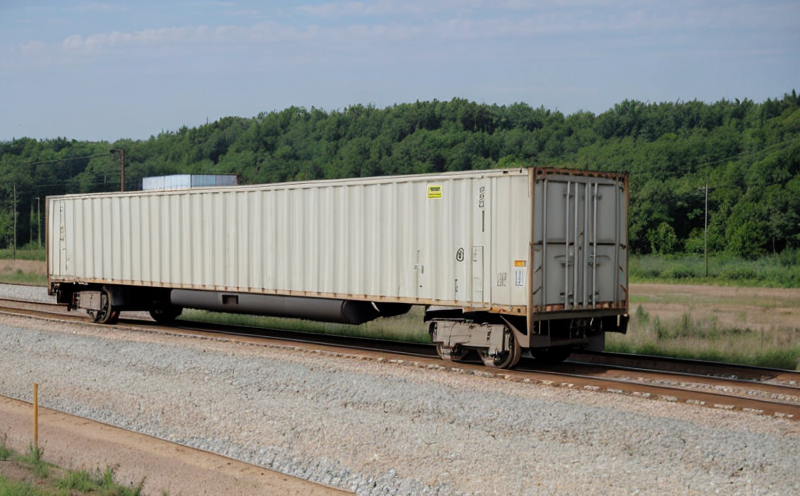EN 15227 Crashworthiness Testing of Freight Wagons
The European standard EN 15227 specifies the requirements and methods for assessing the crashworthiness of freight wagons. This service is essential for ensuring that railway vehicles meet stringent safety standards to protect both passengers and cargo in the event of an accident.
Cargo and freight wagon testing under this standard is critical for several reasons. Firstly, it ensures compliance with international regulations designed to enhance public safety. Secondly, it helps manufacturers optimize their designs, reducing the risk of structural failure during collisions or derailments. Lastly, it supports continuous improvement in railway infrastructure by identifying areas where further enhancements can be made.
The test involves simulating various crash scenarios that a freight wagon might encounter on the tracks. These include head-on impacts with other wagons, side impacts, and vertical drops from elevated positions. By subjecting models to these conditions, we can evaluate how effectively they absorb energy and prevent intrusion into the passenger compartment or cargo area.
Crashworthiness testing is particularly important for ensuring that any potential deformation does not compromise safety. For instance, if a wagon collides with another at high speed, it must be able to withstand significant forces without collapsing completely. This ensures that occupants remain protected and that the integrity of the cargo remains intact.
One key aspect of this testing is the use of advanced finite element analysis (FEA) software to predict how different components will behave under various loads. While this simulation provides valuable insights, physical testing in a controlled environment allows us to validate these models against real-world conditions. This dual approach ensures that our assessments are both accurate and reliable.
To prepare for such tests, specimens must be carefully selected based on their intended use within the railway network. Factors like weight distribution, material composition, and expected operating conditions all play crucial roles in determining which wagons should undergo testing. Once chosen, these models are then subjected to rigorous inspection before being placed into the crash test rig.
The crash test itself typically involves accelerating the wagon towards a barrier or another stationary object at predetermined speeds. Sensors throughout the vehicle collect data on acceleration, deceleration rates, and structural integrity changes during impact. Afterward, engineers analyze this information to determine whether the design meets all specified criteria outlined in EN 15227.
| Aspect | Description |
|---|---|
| Test Conditions | Involves simulating real-world crash scenarios including head-on, side impacts, and vertical drops. |
| Data Collection | Sensors measure acceleration, deceleration rates, and structural deformation during impact. |
| Model Selection | Selects wagons based on their intended use within the railway network for testing. |
The results of these tests are then analyzed to ensure that each wagon complies with all relevant safety standards. Compliance is determined by comparing collected data against predefined acceptance criteria specified in EN 15227.
By adhering strictly to this standard, we contribute significantly to enhancing overall railway safety. This service not only helps manufacturers produce safer products but also supports regulators in establishing robust guidelines that protect both passengers and cargo alike.
Scope and Methodology
| Step | Description |
|---|---|
| Selecting Specimens for Testing | Identify wagons based on their intended use within the railway network. |
| Preparation of Test Specimens | Precisely prepare the selected wagons according to EN 15227 guidelines for testing. |
| Conducting Crash Tests | Subject specimens to various crash scenarios using advanced simulation and physical tests. |
| Data Analysis | Analyze collected data to assess compliance with EN 15227 requirements. |
The methodology employed in crashworthiness testing follows a structured approach aimed at ensuring accurate and reliable results. The first step involves selecting appropriate specimens for testing based on their intended use within the railway network. This ensures that we are evaluating components under realistic operating conditions.
Once selected, these wagons undergo meticulous preparation according to EN 15227 guidelines. During this phase, any necessary modifications or adjustments are made to ensure consistency across all specimens being tested. After thorough preparation, the actual crash tests begin.
In conducting these tests, we employ both simulated and physical methods to comprehensively assess each wagon’s performance under various impact conditions. Simulations allow us to predict how different designs will fare in potential accidents while physical tests provide concrete evidence of real-world outcomes. Both approaches complement one another by offering complementary perspectives on the same issue.
Following the completion of crash testing, extensive data analysis ensues. Engineers carefully examine all gathered information to determine whether each wagon meets all specified criteria outlined in EN 15227. Compliance is established through direct comparison between actual measurements and accepted thresholds defined by the standard.
Benefits
- Ensures compliance with international safety standards like EN 15227.
- Promotes continuous improvement in railway infrastructure through enhanced design practices.
- Reduces risks associated with structural failures during accidents, thereby enhancing overall passenger and cargo safety.
- Supports manufacturers by providing valuable feedback on product performance under realistic crash scenarios.
Eurolab Advantages
We offer comprehensive services tailored specifically to meet the needs of railway and transportation industries. Our team comprises experts with extensive experience in conducting crashworthiness tests according to EN 15227 standards.
Our state-of-the-art facilities provide an ideal environment for accurately replicating real-world conditions, ensuring reliable test results. With advanced instrumentation and sophisticated software tools at our disposal, we can conduct thorough analyses that go beyond basic compliance checks.
This level of detail is crucial when it comes to optimizing designs for maximum safety while maintaining operational efficiency. By leveraging cutting-edge technology combined with expert knowledge, we deliver high-quality testing services that exceed industry expectations.





